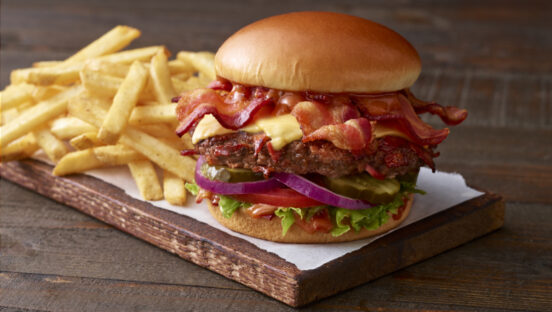QR codes have experienced a resurgence in popularity during the pandemic, most notably as a way for restaurants to provide their guests with contactless menus. But what will become of this trend after the pandemic, when many dining restrictions loosen? With the vaccine rolling out across the country and summer within sight, some people speculate that the QR code menu—an unlikely technological champion of the greatest existential threat ever posed to restaurants—is having its swan song.
However, the well-loved QR code menu is just the first iteration of a bigger impeding shift within the restaurant industry toward multi-channel menus.
What are multi-channel menus?
Multi-channel menus offer guests access to restaurant menus across several types of media, displays, and points of access. This format lets restaurant owners and managers centrally manage their menus in one place and easily publish updates to audiences everywhere.
What does this look like? It means restaurant owners and managers can create text-based and image-based menus on a single platform, then distribute that menu so it’s available across a variety of different channels instantly and simultaneously. For example, the menu can be both published online and sent to a print facility for immediate production—no need for separate versions and different channels of communication and all the headaches that come with them. The online digital menu can be accessed from a computer, phone, digital menu board, or even a TV. Guests can view it by doing an Internet search or by scanning a QR code before they even arrive at a restaurant. And it can happen at the point of sale where guests are ordering food for dine-in or takeout. Guests can even use their smartphone’s voice capabilities to have a text-based menu read aloud to them, making the dining experience more accessible for people with visual impairments.
Furthermore, multi-channel menus support rotating menu options for different times of the day or week for scenarios such as happy hour or weekend brunch specials. This eliminates the need to print multiple types of menus, and dynamic QR code menus can be automated so there’s no effort at all to switch out menu options and no need to re-print QR code signs. Menus can also be organized into different menu groups, each of which can have their own QR code, enabling restaurants to provide different menus at different physical locations within the establishment, such as the bar, patio, and poolside. Businesses that cater to transient locations or events, such as caterers and food trucks, can also leverage menu groups to create menus for specific occasions. Some platforms even have curbside pickup capabilities that customers can use to notify a restaurant that they’ve arrived. With one platform, there are hundreds of ways to create and distribute menus.
Why are multi-channel menus here to stay?
This past month, more than 4 million menus were loaded on the SpotMenus digital menu platform alone—indicating QR code menus are not a trend that will quickly disappear, given that so many establishments are relying on it, and tech-savvy consumers find it so convenient. Even when COVID-19 gets under control and the necessity is no longer present, QR code menus’ convenience and cost savings will make them an integral part of the industry.
Restaurants that have experienced digital menus’ benefits firsthand for over a year now may not have the appetite to ever make themselves fully dependent on physical menus again. It’s hard to rationalize the cost of designing, printing, and reprinting menus regularly when QR code menus cost just dollars per month, or can even be free, and continue to grow in consumer adoption.
For beverage suppliers, the benefits of multi-channel menus extend beyond restaurants. QR codes present a whole new channel for reaching customers with coupons, recipes, and other point-of-sale advertising content at off-premise locations such as grocery stores, liquor stores, and convenience stores. For example, imagine QR code signs on the neck of a wine or spirits bottle that directs customers to recipes and other related information from the brand.
How to gain a competitive advantage with multi-channel menus now
To gain a competitive advantage with multi-channel menus, restaurant owners, managers, and suppliers should align themselves with a digital menu platform that is innovative, well-supported, and looking toward the future of menu management technology. Many digital menu platforms are still evolving to provide a full-service suite of multi-channel menu options and will be there to support establishments in new ways after the pandemic. Others will plateau and fail to serve the changing needs of the industry.
Platforms that strictly remain static QR code generators will likely fall from grace after the pandemic. While some establishments favor online QR code generators because they’re free, they don’t offer the same convenience of a true multi-channel menu platform. Many codes that are created from static QR code generator sites are single-use, meaning, if the menu changes, you must re-create the QR code, re-print it, and re-hang it. There’s also no easy way to manage multiple menu groups or curbside pickup with online QR code generators. Plus, printing professional-looking signage involves more steps, since the signage can’t be created and sent to a print center in a single platform. Users often end up with plain QR codes clumsily taped to a table rather than enticing QR code table tents, coasters, and posters.
Post-pandemic, the imperative debate will not be as binary as deciding between printed or digital menus—these options are not mutually exclusive. The debate will be between choosing a streamlined system for menu management across multiple media types or staying the course taken “B.C.”—before coronavirus.
Richard Mendis is Chief Strategy Officer at BrandMuscle and its no-touch digital menu platform, SpotMenus. He works closely with leading alcohol and beverage brands, suppliers, and distributors to provide point-of-sale marketing solutions that drive revenue and streamline operations.











